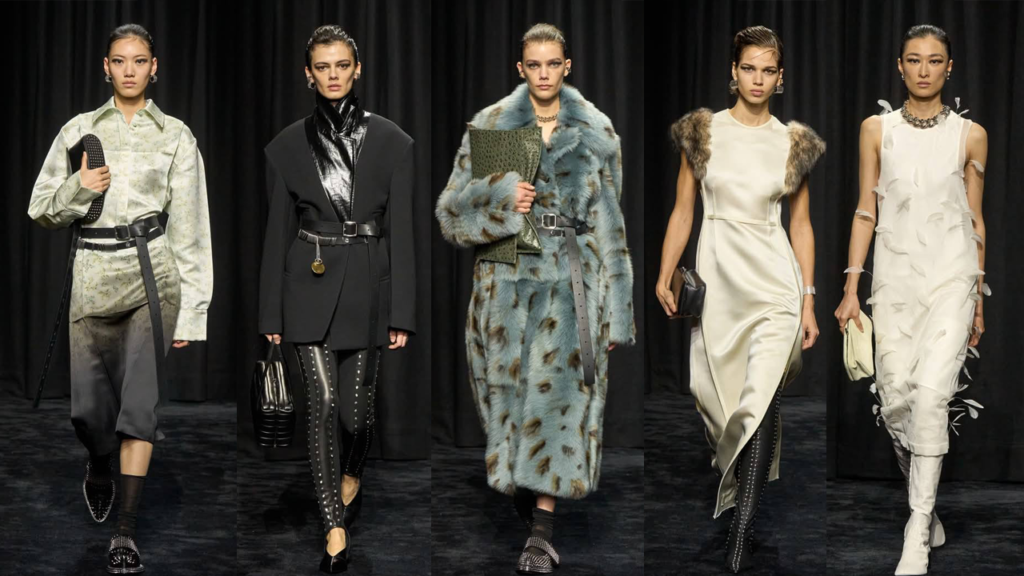A farewell to minimalism: Luke and Lucie Meier’s last collection
Jil Sander presented its FW25 collection on the second day of Milan Fashion Week.
Following the show, the brand announced that creative directors Luke and Lucie Meier would not continue their journey with Jil Sander. A new creative director will be appointed soon, marking a turning point for the brand.
This runway show served as the final farewell for the designers, who played a key role in Jil Sander’s growth with their signature minimalist aesthetic. The brand, owned by OTB Group under Renzo Rosso, is set for a transformation. Rosso has expressed his ambition to elevate Jil Sander to the ultra-luxury segment, positioning it as a competitor to Hermès. The recent appointment of Serge Brunschwig—formerly at Fendi—as CEO signals a new strategic direction.
Expansion and new luxury ventures
Jil Sander has been expanding its global footprint, opening flagship stores in strategic locations. The Ginza-Tokyo store, spanning over 1,000 square meters, is now the brand’s largest worldwide. Additionally, the brand has ventured into new product categories. In December 2024, it introduced its first Fine Jewelry Collection, showcasing craftsmanship and the brand’s refined aesthetic. Then, in January 2025, two years after renewing its licensing agreement with Coty, Jil Sander entered the high-end fragrance market with its first luxury perfume collection.
The decline of minimalism and the shift in fashion trends
Unlike the well-documented growth of Diesel or Maison Margiela, Jil Sander’s financial performance remains undisclosed. However, the declining appeal of quiet luxury is evident. Over recent months, industry experts and consumers alike have shown diminished interest in this aesthetic, favoring bolder, trend-driven fashion. Jil Sander FW25 reflects this shifting landscape.
Jil Sander FW25: The farewell collection by Lucie and Luke Meier
The co-ed FW25 collection unfolded as a poetic metaphor for love and contrast. The designers focused on textures, fabric manipulation, and sculptural silhouettes, staying true to their aesthetic vision.
Set against an entirely black venue, draped in dark carpets and curtains, the atmosphere exuded a gothic sophistication. The result was a deep, visual exploration of light within darkness—a testament to the duo’s mastery of fabric and form.
For menswear, the collection featured structured blazers, Victorian-inspired coats with rooster feather detailing, and motorcycle leather suits in cobalt blue.
Sartorial craftsmanship remained at the core, with coats and tailoring designed for both men and women, emphasizing intricate details and material contrasts. Light played a pivotal role, interacting with shimmering fabrics and three-dimensional textures, enhancing depth and movement.
Fabric innovation and bold experimentation
Silk satin fabrics were reinterpreted using the micro-fringe technique, a trending texture this season. This was elevated by a gradient effect shifting from black to sheer transparency, a striking degradé effect. A standout menswear look featured a coordinated gradient shirt and overcoat, exemplifying this experimental approach.
Tactile elements were further explored through long fringes, faux fur, and dangling embellishments, designed to catch the light and create dynamic movement. While fur has been a dominant trend, Jil Sander chose a maximalist interpretation rather than a minimalist one, emphasizing texture and volume.
Accessories: A reinvention of classic styles
Shoes featured pointed-toe French-style silhouettes alongside studded creepers, a fresh take on the iconic punk-inspired footwear.
Creepers, originally military footwear from World War II, gained popularity through various subcultures, from the Teddy Boys of the ‘50s to punk and goth movements of later decades. For FW25, Jil Sander reimagined them, infusing modern elements into their thick rubber soles and sleek uppers.
Despite the dominance of black, the runway wasn’t devoid of color. Highlights included powder blue faux fur, fringed pink dresses, and a soft pink leather jacket for men.
A new era for Jil Sander
Founded in Germany in 1973 by Heidemarie Jiline Sander, the brand has long been a pillar of German fashion. Often referred to as the “German Armani”, Jil Sander built a legacy on purity, precision, and restraint.
Yet, FW25 signaled a departure from minimalism, embracing maximalist elements in response to market demands. This shift, while conceptually successful, felt distant from the understated elegance that defined the Meiers’ tenure.
The final five looks, in pristine white, stood in stark contrast to the collection’s predominant darkness. Feathers, fringes, and textural appliqués gave the garments a three-dimensional, ethereal quality, suggesting a light at the end of the tunnel.
The show concluded with a standing ovation, marking the end of an era.
While this evolution was inevitable, it is not the Meiers who will lead it. Their contribution to quiet luxury over the past eight years has been significant, and the industry eagerly awaits their next move.
Jil Sander, on the other hand, stands at a crossroads. With a new creative vision on the horizon, its future direction remains uncertain—but undoubtedly, it will be a transformation worth watching.




